


xxxxxThe first attempt to lay a telegraph cable 2,500 nautical miles across the Atlantic was made in August 1857 by two converted warships, the USS Niagara and HMS Agamemnon. It ended in failure when the cable snapped some 380 miles into the journey from Ireland to Newfoundland. The project was resumed in July 1858 with both vessels starting from the middle of the Atlantic, but the cable had to be spliced, and it snapped three times before it was successfully laid at the beginning of August. There was much rejoicing on both sides of the Atlantic, but within a few weeks excessive voltage had burnt out the cable. The next attempt was not made until 1865, soon after the end of the American Civil War, but by this time the cable had been improved and the giant ship The Great Eastern was able to carry the full length. There was initial failure, but In July 1866 the cable was connected at both ends and the transmission of messages, slow to start with, was begun. The American financier Cyrus Field masterminded the project from beginning to end, and, the Irish scientist William Thomson (later Lord Kelvin), by his knowledge of electrical theory, solved the problem of transmitting electric signals under water over long distances. Within 20 years marine cables were linking most parts of the world, and a cable across the Pacific Ocean was completed in 1903.
THE LAYING OF THE TRANSATLANTIC CABLE
1866 (Vb)
Acknowledgements
Route Taken (1858): declared to be in the public domain – commons.wikimedia.org. Printed for Howe’s Adventures and Achievements of Americans, published 1859. Valencia Harbour: date and artist unknown. Great Eastern: detail, steel engraving from an original painting, artist unknown – Public Records Office Northern Ireland, Belfast. Heart’s Content: colour lithograph by the New York printing company Sarony, Major & Knapp (1857-
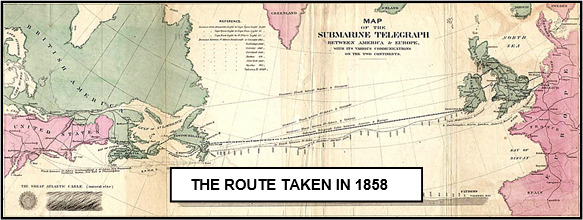 xxxxxThe idea of a transatlantic cable had come to the surface soon after the English physicists William Cooke and Charles Wheatstone had come up with their practical electric telegraph system in 1837, and the American inventor, Samuel Morse had provided the coded “language” to go with it. Within a short while the magnetic telegraph system had made rapid communication possible between the cities of Europe on one side of the Atlantic, and those of North America on the other. Could a link now be made between the continents themselves? Research and experiments as to the feasibility of underwater cables began around 1840 and culminated ten years later in the successful laying of a cable across the English Channel. Then in 1856 a cable was laid across Cabot Strait, linking Cape Ray in Newfoundland with Aspy Bay in Nova Scotia. By then British and American ships were already conducting hydrographic surveys across the Atlantic. Could this vast distance be spanned with like success?
xxxxxThe idea of a transatlantic cable had come to the surface soon after the English physicists William Cooke and Charles Wheatstone had come up with their practical electric telegraph system in 1837, and the American inventor, Samuel Morse had provided the coded “language” to go with it. Within a short while the magnetic telegraph system had made rapid communication possible between the cities of Europe on one side of the Atlantic, and those of North America on the other. Could a link now be made between the continents themselves? Research and experiments as to the feasibility of underwater cables began around 1840 and culminated ten years later in the successful laying of a cable across the English Channel. Then in 1856 a cable was laid across Cabot Strait, linking Cape Ray in Newfoundland with Aspy Bay in Nova Scotia. By then British and American ships were already conducting hydrographic surveys across the Atlantic. Could this vast distance be spanned with like success?
xxxxxA man who certainly thought so was an American financier named Cyrus W. Field, a young man of vision who had made his money as a paper manufacturer. He was both resourceful and determined, but it was to take twelve years, five attempts and a great deal of frustration and disappointment (not to mention millions of dollars) before he and his team of engineers were to achieve their goal. The benefit of such a cable was obvious, but the physical problems involved were enormous, and many of the solutions to them had to be learnt by trial and error. Funds were raised both in America and Britain, and the British government gave Field a yearly subsidy of £1,400. The American government eventually assisted in the project, but there was a great deal of opposition to the idea in both Congress and the House of Representatives. Field himself promoted the Atlantic Telegraph Company and supplied a quarter of the capital required for the project. In New York a group of wealthy business men became known as the “Cable Cabinet”.
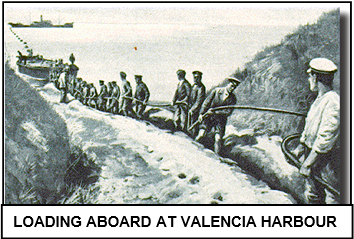 xxxxxThe cable, over 2,500 nautical miles in length, took about six months to make and was ready by June 1857. Having been stowed aboard the two converted warships that had been loaned for the project -
xxxxxThe cable, over 2,500 nautical miles in length, took about six months to make and was ready by June 1857. Having been stowed aboard the two converted warships that had been loaned for the project -
xxxxxHowever, success came -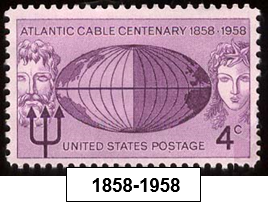 , for example, wrote of the “genius and enterprise of man”, the New York Evening Post rejoiced that the “great heart of humanity” was beating with a single pulse, and the Times of London declared that the Atlantic had dried up and the declaration of 1776 had been “half undone”. On August 16th Queen Victoria sent a telegram to President Buchanan applauding this “additional link” and, in his reply, the President saw the Atlantic telegraph as “destined by Divine Providence to diffuse religion, civilization, liberty and law throughout the world”!
, for example, wrote of the “genius and enterprise of man”, the New York Evening Post rejoiced that the “great heart of humanity” was beating with a single pulse, and the Times of London declared that the Atlantic had dried up and the declaration of 1776 had been “half undone”. On August 16th Queen Victoria sent a telegram to President Buchanan applauding this “additional link” and, in his reply, the President saw the Atlantic telegraph as “destined by Divine Providence to diffuse religion, civilization, liberty and law throughout the world”!
xxxxxUnfortunately, this euphoria was all a little premature. After a few days the signal became progressively weaker, and within a matter of weeks it had failed altogether. The man responsible for the failure was the project’s chief electrician, the Englishman Edward Whitehouse (1816-
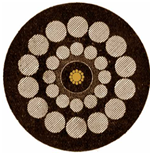 xxxxxIt was to be several years before another attempt was made to lay the cable. Confidence in the project had been seriously undermined, and the outbreak of the American Civil War in 1861 brought further delay. It was not until 1864 that Field, undaunted, was able to form the Telegraph Construction and Maintenance Company and get the project back on track. When work was resumed, however, advantage was able to be taken of a much improved cable, made prior to the laying of a line across the Mediterranean and Red Seas. The core of the cable was made up of seven copper wires, covered with four layers of gutta-
xxxxxIt was to be several years before another attempt was made to lay the cable. Confidence in the project had been seriously undermined, and the outbreak of the American Civil War in 1861 brought further delay. It was not until 1864 that Field, undaunted, was able to form the Telegraph Construction and Maintenance Company and get the project back on track. When work was resumed, however, advantage was able to be taken of a much improved cable, made prior to the laying of a line across the Mediterranean and Red Seas. The core of the cable was made up of seven copper wires, covered with four layers of gutta-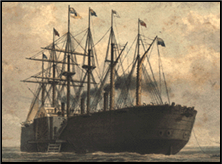
xxxxxAnd another advantage which came with the intervening years was the availability of the Great Eastern (illustrated), launched in 1858 but no longer used commercially. The brainchild of the English engineer Isambard Kingdom Brunel, this giant of a ship, suitably adapted, was capable of carrying the entire cable. There was to be no more splicing.
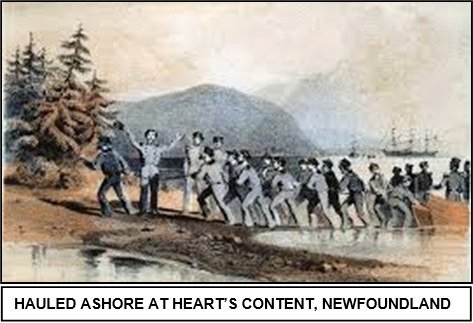
xxxxxIn the first attempt, in fact, made in June 1865, the cable did snap, but a lasting connection was achieved in July 1866, and a second cable was installed in September after the cable which had snapped earlier had been recovered and landed ashore. This time, by using Thomson’s receiver -
xxxxxWhereas a message by ship had taken weeks to deliver, the telegraph line, by means of Morse code, took only a matter of minutes. Nonetheless, for a number of years the cost was extremely high, the speed was only about eight words a minute, and until improvements were made in 1872 the cable could only transmit one message at a time. However, competition slowly brought cost down and increased the volume of trade. By the end of the century fifteen telegraph lines had been laid across the Atlantic and over 100,000 miles of marine cables were linking up many parts of the world. The one across the Pacific Ocean was completed in 1903. In fact, a serious alternative to the cable did not materialise until the advent of communication satellites in the 1960s.
xxxxxIncidentally, the first messages sent on the cable contained the first news item: the signing of the peace treaty between Prussia and Austria, ending the Seven Weeks’ War. ……
xxxxx…… The Times of London sent their correspondent William Howard Russell to report on the attempts made to lay the cable in 1858 and 1865. He produced the first ship’s newspaper, aptly called The Atlantic Telegraph. ……
xxxxx…… The transatlantic cable brought home for the first time the problem created by time differences across the globe. The operators in America were astonished to receive messages several hours before they had been sent!
Including:
Cyrus W. Field and
William Thomson
(Lord Kelvin)

xxxxxAs we have seen, William Thomson (later Lord Kelvin) (1824-
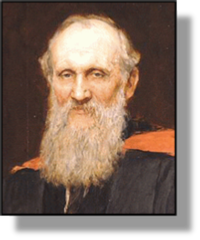 xxxxxAs we have seen, the Irish mathematician and physicist William Thomson (later Lord Kelvin) (1824-
xxxxxAs we have seen, the Irish mathematician and physicist William Thomson (later Lord Kelvin) (1824-
xxxxxAppointed an advisor to the project in 1854, he found himself in public disagreement with the company’s chief electrician Edward Whitehouse when the work of laying the cable got underway. Whitehouse insisted that the inherent reduction in the speed of an electric current when passing through a long underwater cable (known as the “bandwidth problem”) could be overcome by simply increasing the voltage. Thomson disagreed and was proved right. When the cable was successfully laid in August 1858, Whitehouse attempted to improve the weak signal by progressively stepping up the voltage and within a matter of weeks the cable had short circuited to the ocean and burnt out.
xxxxxWhen the third cable was successfully laid in July 1866, full use was made of Thomson’s highly sensitive light-
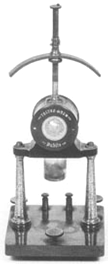
xxxxxThis valuable contribution to the success of the cable brought him fame and fortune. He was knighted in 1866 and raised to the peerage as Baron Kelvin of Largs in 1892. His patent of the mirror galvanometer (illustrated) and that of his subsequent invention, the siphon recorder, (anticipating the modern inkjet printer) made him a wealthy man, as did his consultancy fees in the construction and laying of marine cables across the globe. But whilst his work in that field can be seen as his crowning achievement, it was by no means his only contribution to science. Indeed, his interests were wide and included pioneer work in thermodynamics, electricity, magnetism and hydrodynamics -
xxxxxThomson introduced a third temperature scale in 1848. Known today as the Kelvin Scale, it extends the readings to zero absolute, the point at which all particle motion stops and thus, theoretically, the lowest possible temperature of anything in the universe. The scale’s unit, a “Kelvin”, has the same magnitude as one degree Celsius, and zero (0K) is equivalent to -
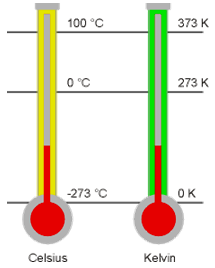 xxxxxIn his study of electricity he established a uniform and accurate system of electrical units, and many of these were adopted internationally by the early 1880s. Meanwhile, his work on electricity and magnetism, in which he expressed their interrelationship in mathematical terms, proved of enormous assistance to the advances made later in this field by the Scottish physicist James Clerk Maxwell. And from his experience at sea, gained during the laying of the transatlantic cable and, later, aboard his own yacht, Thomson invented a number of practical devices, including an improved compass (adopted by the Admiralty), a mechanical means of measuring tides, and an instrument, still in use today, for sounding the depth of the ocean without having to stop the ship.
xxxxxIn his study of electricity he established a uniform and accurate system of electrical units, and many of these were adopted internationally by the early 1880s. Meanwhile, his work on electricity and magnetism, in which he expressed their interrelationship in mathematical terms, proved of enormous assistance to the advances made later in this field by the Scottish physicist James Clerk Maxwell. And from his experience at sea, gained during the laying of the transatlantic cable and, later, aboard his own yacht, Thomson invented a number of practical devices, including an improved compass (adopted by the Admiralty), a mechanical means of measuring tides, and an instrument, still in use today, for sounding the depth of the ocean without having to stop the ship.
xxxxxFrom his university days Thomson also showed a keen interest in geophysical matters such as the shape, age and rotation of the Earth. On the question of age, however, his calculations (20-
xxxxxThomson was born in Belfast, the son of a mathematics teacher. A child with a precocious talent and an insatiable curiosity, he entered Glasgow University at the age of ten and then completed his studies at Cambridge. He was appointed professor of natural philosophy at Glasgow in 1846 and remained there until he retired at the age of 75. One of the major contributors to the development of modern physics, he produced over 600 papers on scientific matters and received honorary degrees from all over the world. He was president of the Royal Society from 1880 to 1895, and served as president of the Royal Society of Edinburgh over many years. In honour of his scientific achievements he was made Baron Kelvin in 1892. He died at his home in Scotland in December 1907 and, fittingly, was buried in Westminster Abbey beside the tomb of the great scientist Sir Isaac Newton.
xxxxxIncidentally, Thomson took his title (Lord Kelvin of Largs) from the River Kelvin which runs through the grounds of Glasgow University on its way to the Clyde, and from Largs, the town on the Scottish coast where he built his imposing manor house. ……
xxxxx…… While a student at Cambridge, he rowed for the university and, as a cornet player, helped to found the university’s music society. ……
xxxxx…… While professor at Glasgow University he opened a physics laboratory -
Vb-
xxxxxThe American businessman Cyrus W. Field (1819-
x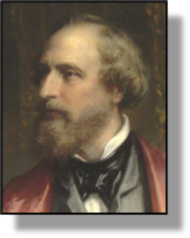 xxxxThe laying of the transatlantic cable in 1866 was a triumph for the American financier Cyrus W. Field (1819-
xxxxThe laying of the transatlantic cable in 1866 was a triumph for the American financier Cyrus W. Field (1819-
xxxxxBorn in Stockbridge, Massachusetts, the son of a clergyman, he began work in New York’s first departmental store at the age of 15 and quickly showed his ability as an entrepreneur. He later joined the staff of a paper wholesaler, and when this company foundered he took it over and made it into a thriving business. It was in January 1854 that, on hearing of a proposal to build a telegraph line from Nova Scotia to Newfoundland, he helped to see this project through and then put his wealth and his enthusiasm behind a scheme to extend the cable somewhat further -
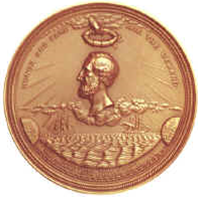 xxxxxFollowing the eventual success of his project in 1866, Field was hailed as a hero and honours were heaped upon him, including a gold medal from Congress. He then went on to take a financial interest in railroad construction, and he also became owner of a New York newspaper. In the late 1880s, however, he lost his fortune on the stock market and fell on hard times. When he died at the age of 72 the epitaph on his tombstone said it all: Cyrus West Field, To whose courage, energy and perseverance, the world owes the Atlantic telegraph.
xxxxxFollowing the eventual success of his project in 1866, Field was hailed as a hero and honours were heaped upon him, including a gold medal from Congress. He then went on to take a financial interest in railroad construction, and he also became owner of a New York newspaper. In the late 1880s, however, he lost his fortune on the stock market and fell on hard times. When he died at the age of 72 the epitaph on his tombstone said it all: Cyrus West Field, To whose courage, energy and perseverance, the world owes the Atlantic telegraph.
xxxxxIncidentally, amongst those Field consulted before starting work on the transatlantic cable was Samuel Morse (who had experimented with underwater cables in 1852), and the American naval officer Lieutenant Matthew Maury (1806-
xxxxx…… Field’s work on the cable brought him into contact with all the leading men of the day, including the Englishmen William Ewart Gladstone, John Bright, Matthew Arnold and Thomas Hughes, and the Americans Henry Wadsworth Longfellow and General William Sherman.


